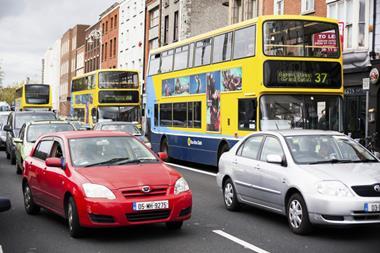The cost of insuring commercial vehicles is rising because of theft, the increasing cost of spares and simply because of less market capacity. But there are ways for customers to get better deals from insurers

When a class of business is sick, insurers frequently turn to the one dose of medicine they know will do the trick quickly – rate rises.
Commercial motor has been a problem child for the UK insurance industry, and this year it emerged some of the big players had fed through near double-digit rate increases.
AXA Insurance reported premium rises of “around 10%” last year and RSA’s recent 2018 interim results refer to a rise of 9%. On the ground, brokers say they are noticing increases, although not quite as large as those reported.
“Throw in a Ford heated windscreen, where the cost of replacement could be twice that of a non-heated one, and you can see that even small claims begin to add up”
Tim Larke, Ryan
Bryan Banbury, managing director of Nottingham-based Russell Scanlan, says: “Insurers are less flexible than perhaps a year or two ago, but we’re certainly not seeing an average rise of 9%. I’ve just talked to an insurer about a fleet of more than 180 vehicles with a loss ratio of more than 90% in the current year and we are likely to agree on a 3% to 4% increase.”
Claims inflation rising
So what is causing commercial motor to need such a stiff rating uptick?
Mark Bramhall, motor underwriting manager at Zurich Insurance, says: “To a certain extent, rate increases in commercial motor premiums are playing catch-up to those we’ve seen over a few years in personal lines due to the historical unprofitability of this book. So, it’s more a sense of inevitability than sudden surprise changes.”
The continued problems caused by rogue whiplash claims and the impact on personal injury settlements of the March 2017 change in the Ogden Discount Rate were also predictable.
More sophisticated vehicles are taking longer to repair and high-tech parts are more costly to replace.
Tim Larke, director at Ipswich based brokers Ryans, says: “Electronics like parking sensors and cameras, sat navs and lane sensors were once the toys and gadgets of costly higher-end cars, but are now much more common.
“Throw in a Ford heated windscreen, for example, where the £500 cost of replacement could be twice that of a non-heated one, and you can see that even small claims begin to add up.”
The cost of importing spares has been boosted by the devaluation of the pound in the aftermath of Brexit, and some suggest manufacturers are also keen to make more money from parts as a result of making less from car sales.
Theft is another major issue, with Allianz Insurance reporting a 20% uplift in the frequency of vehicle theft claims over the last year.
Jonathan Dye, head of motor, technical, at Allianz Insurance, says: “Keyless technology isn’t helping as thieves can buy devices on the internet that jam signals and make owners think they’ve locked cars when they haven’t. Additionally, a reduction in police numbers investigating theft is probably leading to lower recovery rates.”
Then there are certain sectors where rate increases are outstripping the average and having a significant impact on the overall result.
Nick Major, UK chief underwriting officer for Aviva Global Corporate & Specialty, says: “Haulage and self-drive hire are sectors that are becoming increasingly difficult placements due to a contraction in capacity in the market. In recent years the exit of some insurers from these areas has led to the emergence of MGAs willing to offer capacity but only at rates that drive strong pricing adequacy outputs.”
Controlling claims
There are reasons for optimism on the horizon, but nothing is going to be improving overnight.
Insurers are confident that the new technology that is helping to drive up costs will eventually slash accident rates and will reduce cost itself. But we are talking about evolution rather than revolution.
The Civil Liability Bill, which proposes measures to address the whiplash claims problem and establish a more reasonable Ogden Discount Rate, could also eventually make a significant difference.
William Balfry, associate at law firm DWF and spokesperson for the Forum of Insurance Lawyers (FOIL), says: “Unless Tory MPs side with Labour, which is unlikely, the Bill should progress through parliament without difficulty. It is likely to pass in December 2018 but the practical effects will not be felt immediately as there is a great deal to do in the background.
“The government has announced that the earliest that the changes can fully come into force is April 2020 as the litigant-in-person platform needs thorough user testing to make sure it is fit for purpose.”
In the meantime
Until then companies wishing to curb premium increases can take advantage of greater sophistication in insurer underwriting.
Steve Browne, head of casualty, commercial motor and motor trade insurance, at AXA Insurance says: “It’s not all doom and gloom because customers can take a lot into their own hands. There’s plenty of technology around cameras and telematics that fleet managers can use to prove drivers are not at fault in accidents, and we are offering incentives for these to be employed.
“Fleet managers can also do a lot to improve driver standards and check that tyres are in good working condition. We have seen customers who have had substantial rate increases now enjoying significant reductions due to changes they made.”
PASS NOTES
What are the problems with fleet and haulage?
This market’s problems were laid bare when ERS pulled out of general fleet haulage and fleet courier business last year. The motor broker-only insurer said claims inflation was running at around 5% annually and not enough rate was coming through. That was before Ogden. ERS continued in haulage, but only on specialised risks. Other insurers are suffering too and have started to raise prices.
What does it mean for brokers?
Brokers face a fight to find competitive prices in this market. Capacity is exiting from some top tier insurers, leaving MGAs to fill the void. Although the latter are good at service and helping with specialists risks, they can’t hold wide books of different classes that a broker might want in one place – which the likes of Aviva, Allianz and AXA can.
What is the future for this segment?
Technology has the potential to reduce claims. Telematics is excellent at monitoring staff driving behaviour, reducing the chances of a crash. Markerstudy’s VisionTrack business, which installs hi-tech equipment in commercial vehicles, has been a big success. The equipment can even monitor when a driver is not paying attention or dozing off.
What about driverless trucks?
That’s a long way off. The technology is getting closer to producing fully driverless vehicles, but the legislation and road infrastructure is some way behind. A study by Intel predicts the driverless car market will be worth $7trillion, but not until 2050. Driverless cars should start having significant impact by the 2030s.
Hosted by comedian and actor Tom Allen, 34 Gold, 23 Silver and 22 Bronze awards were handed out across an amazing 34 categories recognising brilliance and innovation right across the breadth of UK general insurance.




















































No comments yet